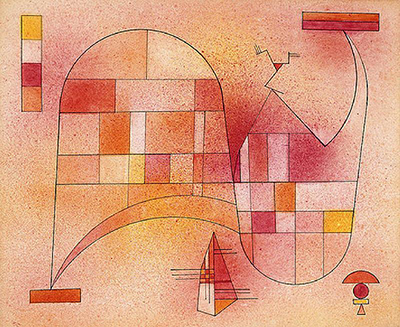Yellow Rose, or Gelb Rosa to give it its original German title, was painted by Wassily Kandinsky in 1929. It hosts the artist's trademark style of abstract shapes and sharp lines.
The artist chose a warm colour palette for this painting, covering the canvas in various tones of reds and oranges with some white for contrast. These were added using watercolour. Once dried, Kandinsky would then place his pen and black ink lines over the top. These would add a much greater clarity to the abstract objects found in the composition. This combination of mediums, plus the abstract style used, is perhaps most similar to the work of Paul Klee in the late 1920s.
This similarity should not be at all surprising because at this point these two artists were starting to drift away from the rest of the Bauhaus movement. Kandinsky chose to concentrate on paintings and drawings around this time and started to organise exhibitions of his work in Paris in order to build up a following that could later prove financially beneficial. Despite drifting away from this highly significant artistic movement, these two individuals are probably the two most famous names to have ever attended. It's overall influence on design generally was profound, with many other contributors to this movement also being held in high esteem today.
This painting was sized at 40.5cm x 48.1cm (15.9 x 18.9 inches) and came at a time when Kandinsky was moving to a greater abstraction which made it harder to identify the elements of his work. There was also less use of motifs that could be seen repeatedly earlier.




